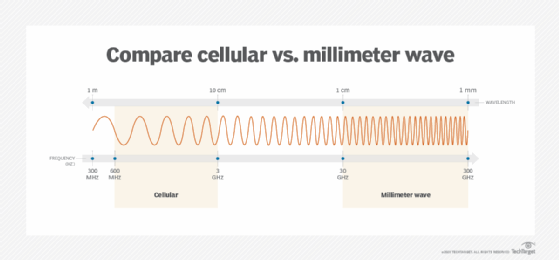millimeter wave (mmWave)
What is millimeter wave (mmWave)?
Millimeter wave (mmWave), also known as millimeter band, is a range of electromagnetic frequencies between microwaves and infrared. Its frequency spectrum is used for wireless high-speed communications. It is also known as the extremely high frequency, or EHF, band by the International Telecommunication Union.
One of the predominant uses of mmWaves is for 5G. Communications based on this band of frequencies are fast and provide increased bandwidth, making it ideal for network carriers to provide faster service to bandwidth-intensive applications. The mmWave band contains wavelengths between 10 millimeters at 30 gigahertz and 1 millimeter at 300 GHz.

When used for 5G signals, mmWaves are produced using small, low-power cells called small cells. Small cells are deployed as a network in clusters to provide acceptable coverage in an area.
Because of the high frequency of mmWaves, they have a limited range. And because of this limited range, 5G also uses lower-frequency bands called Sub-6 5G, which aren't in the mmWave range. Sub-6 5G is still typically faster than average 4G LTE speeds.
Advantages of millimeter wave
Advantages of using mmWaves include the following:
- It enables higher data rates compared with lower frequencies when used in telecommunications, such as those used for Wi-Fi and current cellular networks.
- The higher frequency range has a high tolerance for bandwidth.
- It offers less latency due to its higher speeds and bandwidth.
- There is less interference, as mmWaves don't propagate and interfere with other neighboring cellular systems.
- The short propagation distance of mmWaves can increase the number of access points to cover a large area.
- Small cells facilitate the reuse of channels across wireless local area network (WLAN) coverage areas.
- Antennas for mmWave devices are smaller than for other frequencies, making them more suitable for small internet of things or IoT devices.
- It offers increased data capacities, meaning that mmWave networks can handle more traffic compared with other frequencies.
Disadvantages of millimeter wave
Despite the noticeably large increase in speed that mmWave offers, it does come with noticeable disadvantages as well. These include the following:
- Millimeter waves travel by line of sight and are blocked or degraded by physical objects such as trees, walls and buildings. Their propagation is also affected by proximity to humans and animals, primarily due to their water content.
- Millimeter waves are absorbed by gases and moisture in the atmosphere, which reduces the range and strength of the waves. Rain and humidity reduce their signal strength and propagation distance, a condition known as rain fade. The propagation distance at the lower frequencies is up to 1 kilometer, while the higher frequencies travel only a few meters.
- The costs associated with manufacturing mmWave-capable hardware are higher. To provide adequate coverage, small cell networks must also be installed in clusters.
Millimeter wave uses
Millimeter waves can be used in a broad range of products and services, such as high-speed, point-to-point WLANs and broadband access. Other uses of mmWaves include the following:
- In 5G cellular telecommunications, as cellular networks use mmWaves in the 24 to 39 GHz bands. 5G mmWave bands provide high-bandwidth capacities, which is useful in settings with a lot of users, such as in stadiums.
- In telecommunications, mmWaves are used for high-bandwidth WLANs and short-range personal area networks.
- IoT devices use mmWaves, as their high bandwidth capacity is ideal for applications such as short-distance wireless transmission of ultra-high-definition video and communications.
- Autonomous vehicles can use mmWaves, as the limited propagation distance and high data rates make mmWaves ideal for communications between these vehicles.
- Airport security scanners can use mmWaves to scan bodies with precision and cause less harm to subjects. It operates at a frequency range of 70 to 80 GHz.
Comparison with other spectrums
In comparison, Wi-Fi currently uses frequencies in the 2.4 GHz, 5 GHz and 6 GHz bands, which are known as microwave bands. Cellular networks use frequencies in the 600 to 700 megahertz and 2.5 to 3.7 GHz bands. These bands propagate farther than millimeter wave, but support lower bandwidths. Frequencies above mmWave are in the low infrared spectrum and are limited to short, line-of-sight communications.
5G spectrums are divided by mmWaves (high-band) and Sub-6 5G (low- and mid-band). Low bands are slower than mmWaves under 1 GHz, but still faster than some 4G LTE speeds.
Mid-bands, by comparison, range from 3.4 to 6 GHz. Mid-band 5G is faster than low-band, and -- even though it is not as fast -- it has more coverage than mmWave.
Although 5G speeds are much faster than 4G, due to the range limitations of 5G, 4G LTE likely won't be phased out for a while. Learn more about how 4G and 5G compare in this article.






